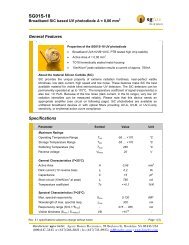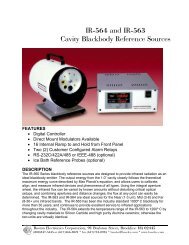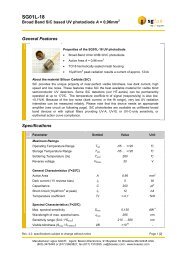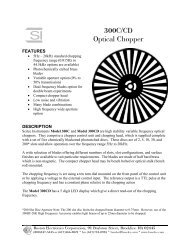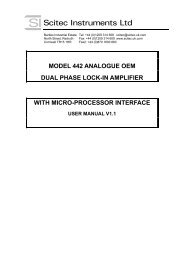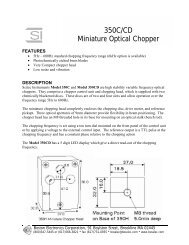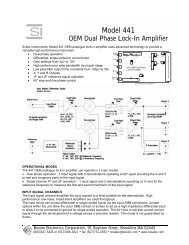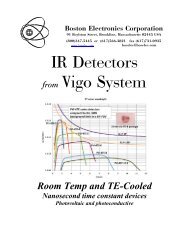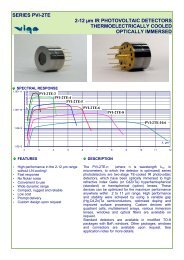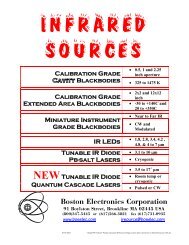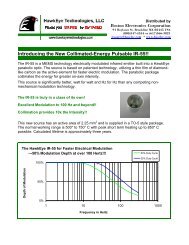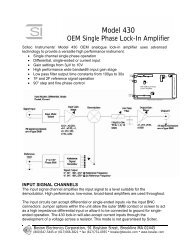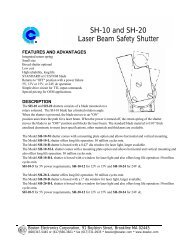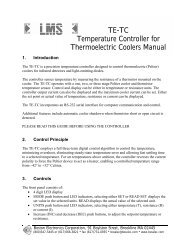TCSPC for FLIM and FRET in - Boston Electronics Corporation
TCSPC for FLIM and FRET in - Boston Electronics Corporation
TCSPC for FLIM and FRET in - Boston Electronics Corporation
Create successful ePaper yourself
Turn your PDF publications into a flip-book with our unique Google optimized e-Paper software.
variable lateral field builds up <strong>in</strong> front of the photocathode that distorts the image <strong>and</strong> impairs theimage resolution.Modulat<strong>in</strong>g the voltage across the channel plate [55] has also been attempted. The drawback of thismethod is the heat<strong>in</strong>g of the channel plate due to dielectric losses <strong>and</strong> the low degree of modulation.The microscope setup <strong>for</strong> a modulated image <strong>in</strong>tensifier is shown <strong>in</strong> fig. 24. The setup is verysimilar to that <strong>for</strong> the gated image <strong>in</strong>tensifier.CWLaserFreqencySynthes.PulsedLaserFreqencySynthes.AOMAOMDriverAOMAOMDriverTelescopeVariablePhase ShiftScanMirrorScann<strong>in</strong>g HeadScanMirrorVariablePhase ShiftAmplifierScanLensAmplifierGridGridImageofSample-HV + MCP -MicroscopeObjectiveSampleCCDImageIntensifierObjectiveSampleImageofSample-HV+ MCP -CCDImageIntensifierFig. 24: Modulated image <strong>in</strong>tensifier used at a wide field microscope (left) <strong>and</strong> at a scann<strong>in</strong>g microscope (right)A frequency synthesiser generates a modulation frequency which is typically <strong>in</strong> the range of50 MHz to 500 MHz. This frequency is used to modulate the excitation light <strong>and</strong> the image<strong>in</strong>tensifier. A variable phase shifter is used to change the phase relation between the modulation ofthe light source <strong>and</strong> the modulation of the image <strong>in</strong>tensifier. From three images acquired at differentphase shifts the phase of the fluorescence signal referred to the excitation can be calculated.Instead of the phase shifter a heterodyne technique can be used. In this case the image <strong>in</strong>tensifier ismodulated with a slightly different frequency than the laser. This causes the phase between the twomodulations to change cont<strong>in</strong>uously. If the difference frequency is a few Hz a sequence of imagescan be obta<strong>in</strong>ed <strong>for</strong> each period of the difference frequency [55]. The heterodyne technique requiresa good frequency synthesiser that delivers the two modulation frequencies <strong>and</strong> the difference of bothwith high frequency <strong>and</strong> phase stability.A s<strong>in</strong>gle phase measurement at a fixed frequency allows to determ<strong>in</strong>e the time constant of a s<strong>in</strong>gleexponential fluorescence decay function. To resolve the components of a multi-exponential decaymeasurements at different frequencies are required. Ideally, the modulation frequencies should be ofthe order off mod = 1 / 2Πτ f withf mod = Modulation Frequency, τ f = Fluorescence decay time constantAt this frequency the change of the phase is at maximum <strong>for</strong> a given change of the decay timeconstant. For decay components below a few 100 ps the optimum frequency is around 1 GHz.Modulation frequencies of this order are almost impossible to achieve with st<strong>and</strong>ard image21



